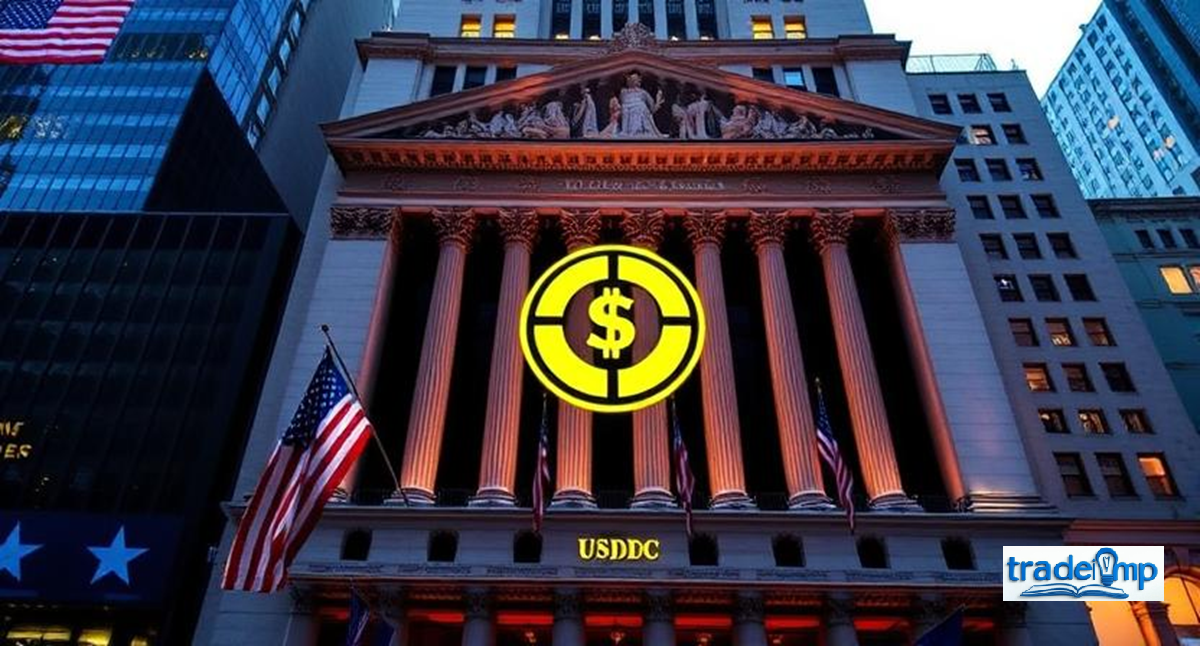Circle, the company behind the stablecoin USD Coin (USDC), is making headlines as it considers a potential listing on the New York Stock Exchange (NYSE). This development comes at a crucial time when USDC’s market capitalization has surged past the $60 billion mark, underscoring its growing significance in the cryptocurrency and financial sectors. This article explores the implications of Circle’s potential NYSE listing, the rise of USDC, regulatory considerations, competitive landscape, and the broader impact on the crypto industry. NYSE Listing as USDC Market Cap
The Rise of USD Coin (USDC)
What is USDC?
USDC is a stablecoin pegged to the US dollar on a 1:1 basis, designed to offer stability in the volatile crypto market. It is issued by Circle in partnership with Coinbase under the Centre Consortium. Unlike cryptocurrencies such as Bitcoin and Ethereum, which experience high price fluctuations, USDC provides a predictable and stable digital asset for transactions and investments. Circle Eyes NYSE Listing as USDC Market Cap Hits $60 Billion Milestone
Factors Behind USDC’s Growth
The rapid growth of USDC’s market capitalization can be attributed to several key factors:
- Institutional Adoption: Major financial institutions and businesses have integrated USDC for payments and settlements.
- DeFi Expansion: USDC has become a preferred stablecoin in decentralized finance (DeFi) applications, including lending, borrowing, and staking.
- Regulatory Clarity: Unlike some other stablecoins, USDC has maintained transparency and compliance with regulatory standards, increasing trust among investors.
- Cross-Border Transactions: The demand for fast, low-cost international transactions has fueled USDC’s adoption worldwide.
USDC vs. Tether (USDT)
USDC competes with Tether (USDT) as one of the leading stablecoins. While Tether holds a higher market cap, concerns over its reserves and transparency have led some investors to prefer USDC, which undergoes regular audits and provides more regulatory assurances.
Circle’s Journey Toward an NYSE Listing
Previous Attempts to Go Public
Circle has long expressed interest in becoming a publicly traded company. In 2021, it announced plans to go public through a special purpose acquisition company (SPAC) merger with Concord Acquisition Corp. However, the deal was later abandoned due to regulatory concerns and market conditions.
Why an NYSE Listing Now?
Several factors make this an opportune moment for Circle to pursue an NYSE listing: Circle Eyes NYSE Listing as USDC Market Cap Hits $60 Billion Milestone
- Market Confidence: USDC’s market cap crossing $60 billion signals strong demand and investor confidence.
- Regulatory Developments: The growing push for stablecoin regulation could provide a more favorable environment for Circle’s public debut.
- Competitive Positioning: As regulatory scrutiny increases on rival stablecoins, Circle’s commitment to compliance gives it an edge.
- Institutional Backing: With major financial partners, Circle is in a strong position to attract institutional investors through an IPO.
Potential Benefits of a Public Listing
An NYSE listing could bring multiple advantages to Circle, including:
- Increased Capital Access: Raising funds through public markets can accelerate Circle’s expansion and innovation.
- Enhanced Credibility: A public listing enhances transparency, fostering greater trust among regulators and investors.
- Market Expansion: The ability to trade on traditional stock exchanges could introduce USDC to a broader investor base.
- Regulatory Compliance: Being a publicly traded company might help Circle navigate regulatory challenges more effectively.
Regulatory Considerations
Stablecoin Regulations in the US
Regulatory oversight is a crucial factor in Circle’s NYSE ambitions. Stablecoins are under increasing scrutiny, particularly regarding reserve transparency and systemic risks.
- The Stablecoin Transparency Act: This proposed legislation aims to establish clear guidelines for stablecoin issuers, including audits and reserve disclosures.
- Federal Reserve and SEC Oversight: Regulatory bodies are debating how stablecoins should be classified and monitored within the financial system.
- Biden Administration’s Stance: The White House has emphasized the need for stablecoin regulations to prevent financial instability and illicit activities.
Compliance Challenges
While Circle has maintained transparency, regulatory hurdles remain. The company must address concerns over:
- Reserve Backing: Ensuring all USDC tokens are fully backed by cash or cash-equivalent assets.
- Anti-Money Laundering (AML) Measures: Strengthening compliance with AML and Know Your Customer (KYC) regulations.
- Tax Implications: Clarifying how transactions involving USDC are taxed for individuals and businesses.
Market Impact of Circle’s Potential Listing
Effect on the Crypto Market
A successful NYSE listing for Circle could:
- Boost Stablecoin Adoption: Encourage wider use of USDC in financial transactions and DeFi.
- Increase Institutional Involvement: Attract more traditional financial institutions to the crypto space.
- Elevate Crypto Market Stability: Provide a more regulated and transparent alternative to existing stablecoins.
Effect on Circle’s Competitors
- Tether (USDT): Increased regulatory scrutiny may push investors toward USDC.
- Binance USD (BUSD): Regulatory challenges for Binance could make USDC a more attractive option.
- PayPal’s PYUSD: PayPal’s stablecoin initiative may intensify competition but also validate the stablecoin market.
Broader Financial Implications
Integration with Traditional Finance
A publicly traded Circle could bridge the gap between crypto and traditional finance, enabling more:
- USDC-Based Payment Solutions: Greater adoption for business transactions and remittances.
- Tokenized Assets and Smart Contracts: Enhanced financial products built on blockchain technology.
- Partnerships with Banks: Collaboration with traditional banks for digital dollar initiatives.
Risks and Challenges
Despite the potential benefits, Circle faces significant risks, including:
- Regulatory Uncertainty: Evolving regulations may impact business operations.
- Market Volatility: Crypto markets remain unpredictable, affecting investor sentiment.
- Competitive Pressure: Rivals continue to innovate, requiring Circle to maintain a competitive edge.
Conclusion
Circle’s potential NYSE listing marks a significant milestone in the evolution of stablecoins and the broader cryptocurrency market. With USDC surpassing a $60 billion market cap, the company is well-positioned to capitalize on growing demand for digital assets. However, regulatory challenges and competition remain key hurdles. If successful, Circle’s listing could legitimize stablecoins in mainstream finance and pave the way for broader adoption of digital currencies worldwide.




